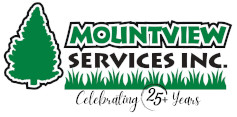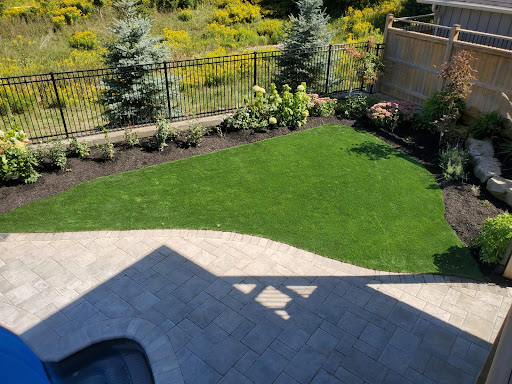The goal of a pet-friendly yard is typically two-fold: to keep your gorgeous landscaped space safe from the exploratory nature of pets, as well as to provide a space that is safe and inviting for your furry friends all year round.
Some homeowners find it difficult to strike the ideal balance, as pets can leave yellow or dead spots in the lawn, dig holes in the ground, and often leave a trail of crushed and trampled flowers behind them. Pets require an outdoor space that is safe for them to sleep, play, and sunbathe and that is also welcoming and stimulating for them.
Read on to discover our top 8 tips for creating an outdoor space that is perfect for your entire family, both two-legged and four.
Consider Hardscaping
When you are designing your space, consider incorporating some hardscaping elements. Hardscaping refers to any landscape materials that are not soft, such as bricks, stone, tiles, concrete, and pebbles. Creating a landscape that is well-balanced often involves combining both softscaping and hardscaping. Consider an elegant stone pathway that winds between flower beds and shrubbery, a stone retaining wall, patio stones, or a beautiful water feature.
Hardscaping is ideal for pet-friendly spaces as it can make your yard less vulnerable to staining, digging, and trampling while establishing natural pathways and boundaries without the use of fencing.
Be Thoughtful About Your Plants
Traffic from pets can be hard on your space, often resulting in trampled flower beds or half-eaten plants. One of the most effective ways to create a pet-friendly yard is to be intentional in the plants and grasses you choose to plant. Choosing a hardy species of grass, such as Kentucky bluegrass or ryegrass, can help your lawn stand up to running and digging pets. Native grasses are also notoriously hardy and safe options, with the bonus of requiring less water.
It is also important to be mindful of the fact that most pets will eat, or attempt to eat, almost anything. Unfortunately, many popular plants and flowers are toxic to pets, including:
- African daisy
- Aloe
- Asparagus fern
- Azalea
- Bamboo
- Begonia
- Boston fern
- Boxwood
- Daffodil
- Daylily
- English ivy
- Jasmine
- Snapdragon
- Wisteria
Incorporating only pet-safe plants into your garden is the most effective way to ensure you have a dog-friendly yard or a cat-friendly garden. It is possible, however, to include plants and herbs that are toxic to your pets, with some consideration. Using some chicken wire fencing or planting them out of reach of your pets can often be enough to keep your pets safe.
Designate Areas for Your Pets
Another method of creating a pet-safe outdoor space is to designate certain areas for specific uses. Breaking your yard into different sections can make it optimally designed for both humans and pets to enjoy. If you have a pet that lives to dig, consider making a specific digging area in your yard. You can also establish a ‘marking’ pole or tree to encourage your pet to relieve themselves away from human-occupied areas. By creating specific pet play areas, you ensure that your gardens are unharmed and your pet has the space they need to enjoy the outdoors.
Consider a Fence
In many cases, a fence is the optimal way to ensure your yard is safe and fun for your pets. There are so many varieties of beautiful fencing available, so don’t think you’re stuck with a chain-link fence as your only option.
Fencing can be used to enclose your entire yard or to divide your outdoor space into areas designated for human and pet use. This can be a good way to ensure you get the best of both worlds: an intricately landscaped space and a space that is meant only for your pets to enjoy and exercise.
Be Thoughtful About Irrigation
In most parts of Ontario, irrigation is a critical aspect of keeping your yard lush and healthy. In order to protect your grass and other plants, try to keep your pet indoors after watering. Wet grass is more vulnerable to damage and can also make for some muddy paws and fur, which can make a mess in your home.
Create Shade
While the sunshine is essential for the health of your yard, it is important to ensure that your pets have access to shade, especially if they will be outdoors for extended periods during the warmer months. Just like humans, pets can experience sunburns, dehydration, and heat stroke.
When designing your yard, make sure there will be shade for your pets. This can include existing trees or adding larger shrubs, which tend to grow fairly quickly. If necessary, create shade with a dog house or overhead tarp.
Eliminate any Chemicals
Synthetic fertilizers, pesticides, and herbicides are not only detrimental to the environment, but they are also highly toxic to pets. Some of the most popular pesticides can cause organ failure, cancer, and poisoning. Consider using organic and natural pest control methods such as diatomaceous earth and pet-safe essential oils.
Work with Professional Landscapers
The trick to designing a perfect outdoor space for your family and pets is to create a balance between human and animal needs. At Mountview Services, we offer expertise and experience when it comes to pet-friendly landscaping.
To learn more about creating a pet-safe outdoor space or to receive a landscaping project quote, contact us at Mountview Services today!

